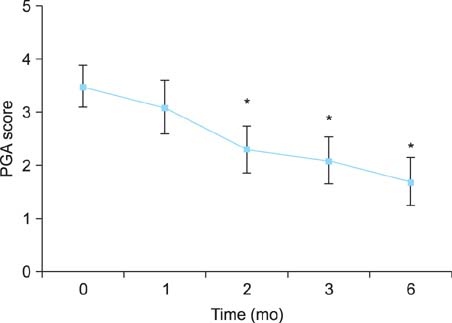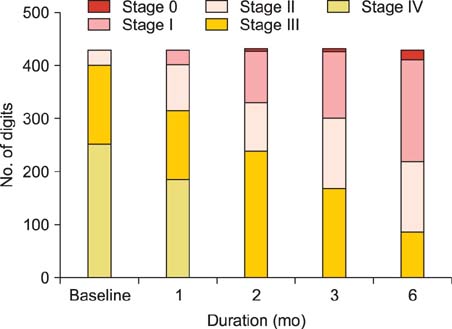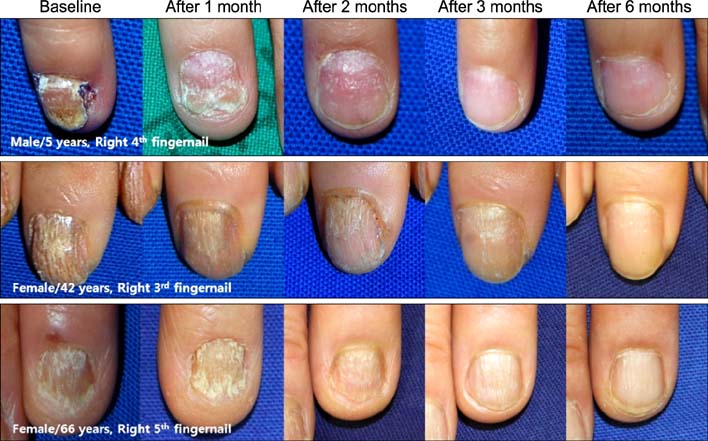Ann Dermatol.
2015 Aug;27(4):371-375. 10.5021/ad.2015.27.4.371.
Efficacy and Safety of Calcipotriol/Betamethasone Dipropionate Ointment for the Treatment of Trachyonychia: An Open-Label Study
- Affiliations
-
- 1Department of Dermatology, Pusan National University School of Medicine, Yangsan, Korea. drkmp@hanmail.net
- 2Department of Dermatology, Pusan National University Yangsan Hospital, Yangsan, Korea.
- 3Research Institute for Convergence of Biomedical Science and Technology, Pusan National University Yangsan Hospital, Yangsan, Korea.
- 4Bio-Medical Research Institute, Pusan National University Hospital, Busan, Korea.
- KMID: 2171491
- DOI: http://doi.org/10.5021/ad.2015.27.4.371
Abstract
- BACKGROUND
Despite efforts to treat trachyonychia, there is no promising treatment modality.
OBJECTIVE
This study evaluated the efficacy and safety of calcipotriol plus betamethasone dipropionate ointment on trachyonychia.
METHODS
A total of 39 patients with 432 nails affected by trachyonychia were enrolled. All patients applied calcipotriol/betamethasone ointment once daily without occlusion for 6 months. Outcome measures were assessed by physician's global assessment (degree of roughness: 0, clear; 1, mild; 2, moderate; 3, marked; 4, severe) at all time points.
RESULTS
After 6 months of therapy, 98.6% (426/432) of nails showed significant clinical improvement; 4.2% were completely free from nail lesions. The mean physician global assessment score decreased significantly from 3.5 to 1.7 points (p< 0.05). No serious side effects were reported, except mild pruritus and erythema in 2 patients.
CONCLUSION
This is the first study to prospectively evaluate the efficacy and safety of calcipotriol/betamethasone ointment for the treatment of trachyonychia. The results indicate topical calcipotriol/betamethasone is an effective and safe treatment for symptom improvement of trachyonychia.
Keyword
MeSH Terms
Figure
Cited by 1 articles
-
Therapeutic Efficacy of Combination Therapy Using Oral Cyclosporine with a Dietary Supplement (Pantogar®) in Twenty-Nail Dystrophy
Su Jin Oh, Jeong Eun Kim, Joo Yeon Ko, Young Suck Ro
Ann Dermatol. 2017;29(5):608-613. doi: 10.5021/ad.2017.29.5.608.
Reference
-
1. Gordon KA, Vega JM, Tosti A. Trachyonychia: a comprehensive review. Indian J Dermatol Venereol Leprol. 2011; 77:640–645.
Article2. Sakata S, Howard A, Tosti A, Sinclair R. Follow up of 12 patients with trachyonychia. Australas J Dermatol. 2006; 47:166–168.
Article3. Peloro TM, Pride HB. Twenty-nail dystrophy and vitiligo: a rare association. J Am Acad Dermatol. 1999; 40:488–490.
Article4. Khandpur S, Reddy BS. An association of twenty-nail dystrophy with vitiligo. J Dermatol. 2001; 28:38–42.
Article5. Khandpur S, Bansal A, Sharma VK, Bhatti SS, Singh MK. Twenty nail dystrophy in vitiligo. J Dermatol. 2007; 34:189–192.
Article6. Scardamaglia L, Howard A, Sinclair R. Twenty-nail dystrophy in a girl with incontinentia pigmenti. Australas J Dermatol. 2003; 44:71–73.
Article7. Sehgal VN. Twenty nail dystrophy trachyonychia: an overview. J Dermatol. 2007; 34:361–366.
Article8. Soda R, Diluvio L, Bianchi L, Chimenti S. Treatment of trachyonychia with tazarotene. Clin Exp Dermatol. 2005; 30:301–302.
Article9. Schissel DJ, Elston DM. Topical 5-fluorouracil treatment for psoriatic trachyonychia. Cutis. 1998; 62:27–28.10. Halkier-Sørensen L, Cramers M, Kragballe K. Twenty-nail dystrophy treated with topical PUVA. Acta Derm Venereol. 1990; 70:510–511.11. Khoo BP, Giam YC. A pilot study on the role of intralesional triamcinolone acetonide in the treatment of pitted nails in children. Singapore Med J. 2000; 41:66–68.12. Tosti A, Piraccini BM, Cambiaghi S, Jorizzo M. Nail lichen planus in children: clinical features, response to treatment, and long-term follow-up. Arch Dermatol. 2001; 137:1027–1032.13. Brazzelli V, Martinoli S, Prestinari F, Borroni G. An impressive therapeutic result of nail psoriasis to acitretin. J Eur Acad Dermatol Venereol. 2004; 18:229–230.
Article14. Piérard GE, Piérard-Franchimont C. Dynamics of psoriatic trachyonychia during low-dose cyclosporin A treatment: a pilot study on onychochronobiology using optical profilometry. Dermatology. 1996; 192:116–119.
Article15. Park JY, Rim JH, Choe YB, Youn JI. Comparison of calcipotriol monotherapy and a combination of calcipotriol and methylprednisolone aceponate therapy in psoriasis patients. Ann Dermatol. 2003; 15:60–63.
Article16. Rigopoulos D, Gregoriou S, Daniel Iii CR, Belyayeva H, Larios G, Verra P, et al. Treatment of nail psoriasis with a two-compound formulation of calcipotriol plus betamethasone dipropionate ointment. Dermatology. 2009; 218:338–341.
Article17. Baran R, Dawber RPR, Richert B. Physical signs. In : Baran R, Dawber RPR, de Berker DAR, Haneke E, Tosti A, editors. Diseases of the nails and their management. 3rd ed. Oxford: Blackwell Science;2001. p. 67–69.18. Tosti A, Bardazzi F, Piraccini BM, Fanti PA. Idiopathic trachyonychia (twenty-nail dystrophy): a pathological study of 23 patients. Br J Dermatol. 1994; 131:866–872.
Article19. Grover C, Khandpur S, Reddy BS, Chaturvedi KU. Longitudinal nail biopsy: utility in 20-nail dystrophy. Dermatol Surg. 2003; 29:1125–1129.
Article20. Theng CT, Tan SH, Goh CL, Suresh S, Wong HB, Machin D. Singapore Lichen Planus Study Group. A randomized controlled trial to compare calcipotriol with betamethasone valerate for the treatment of cutaneous lichen planus. J Dermatolog Treat. 2004; 15:141–145.
Article21. Basak PY, Ergin S. Comparative effects of calcipotriol and betamethasone 17-valerate solution in the treatment of seborrhoeic dermatitis of the scalp. J Eur Acad Dermatol Venereol. 2001; 15:86–88.
Article22. Wolf R, Tur E, Brenner S. Corticosteroid-induced disappearing digit. J Am Acad Dermatol. 1990; 23:755–756.
Article23. Lebwohl M. Topical application of calcipotriene and corticosteroids: combination regimens. J Am Acad Dermatol. 1997; 37:S55–S58.
- Full Text Links
- Actions
-
Cited
- CITED
-
- Close
- Share
- Similar articles
-
- Combination Therapy of Topical CCB (Combination of Calcipotriol and Betamethasone Dipropionate) Gel and Narrowband Ultraviolet B (NBUVB) in the Treatment of Vitiligo: An Intraindividual Right-Versus-Left Comparison Study with Topical Be
- Calcipotriol ( MC903 ) Ointment in the Treatment of Psoriasis
- A Clinical Study of Calcipotriol Ointment in the Treatment of Psoriasis Vulgaris
- A case of psoriasis vulgaris treated with calcipotriol ointment
- A clinical study of calciportriol ointment(MC 903) in the treatment of psoriasis





